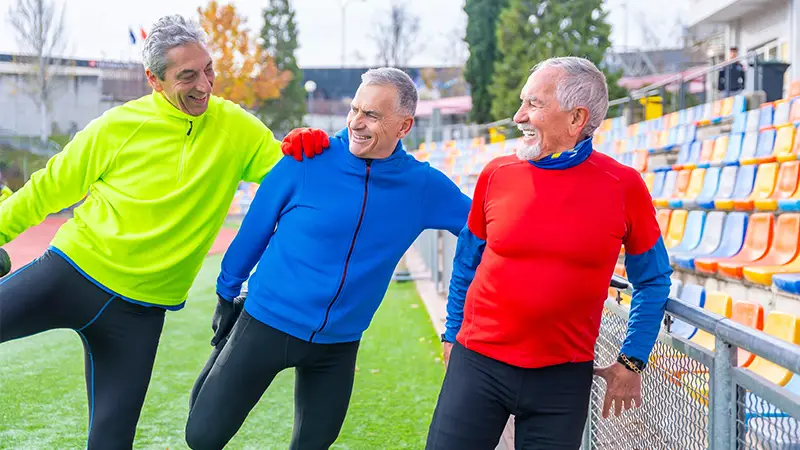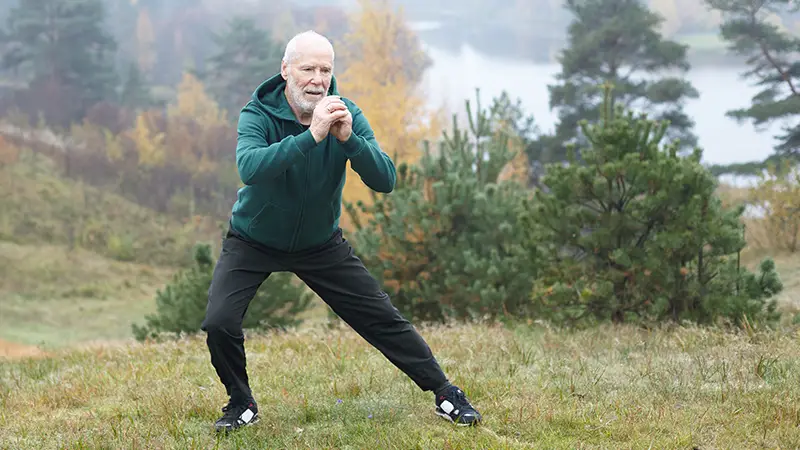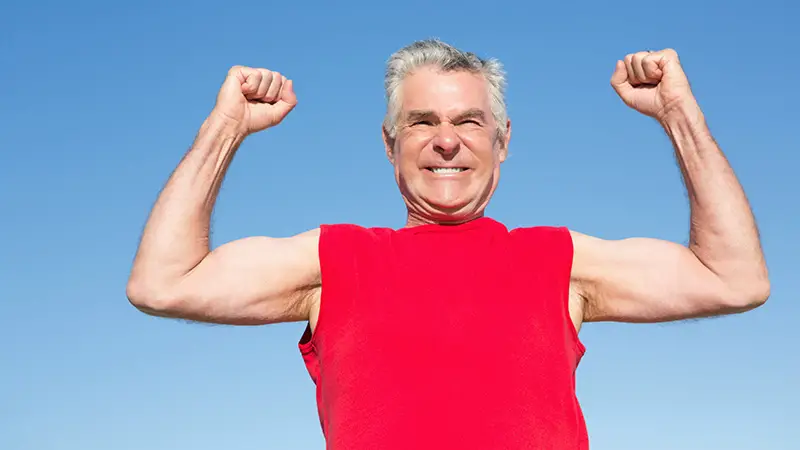As we step into our golden years, the journey doesn’t have to be a solitary one. Group fitness classes offer an incredible way to boost wellbeing, fostering a sense of community while focusing on physical health.
They’re not just about breaking a sweat – they’re about breaking the mold of what it means to age gracefully.
In these classes, you’ll find more than just a workout routine. You’ll find a supportive environment, structured activities, and a chance to connect with others. It’s an opportunity to combat loneliness, improve mental health, and strive towards your personal peak.
In this article, we’ll explore the top 10 benefits of group fitness classes for seniors. From physical perks to the social aspect, you’ll discover why these classes are a perfect fit for your lifestyle and preferences. Let’s dive into the myriad advantages and guide you on your journey to finding the ideal class.

Exploring the Top 10 Benefits of Senior Fitness Classes
Immersing in fitness classes specifically tailored for seniors uncovers a plethora of benefits. Here are noteworthy mentions that stand as a testimony to the efficacy of these sessions.
1. Improved Cardiovascular Health

Regular physical workout, a mainstay in senior fitness classes, bolsters cardiovascular health. It strengthens the heart, reduces blood pressure, and improves circulation.
As an upshot, risks related to heart diseases take a significant plunge. Moreover, these classes enhance muscle strength and flexibility, promoting balance and coordination.
Regular participation helps manage chronic conditions like arthritis, diabetes. Cognitive health also improves, reducing the risk of dementia. Mental wellness is fostered as social interactions increase in these group activities. It’s a holistic approach to aging gracefully.
2. Enhanced Cognitive Function

Physical fitness enhances cognitive function. One particular highlight is the increased mental clarity that accompanies physical exercise.
Besides, the release of mood-elevating hormones contributes to a sharper mind. Furthermore, senior fitness classes offer a supportive environment that fosters social interaction and reduces isolation.
Participants experience better sleep patterns, improved flexibility, increased strength and balance, leading to reduced fall risk. They also promote healthy aging by slowing the progression of chronic diseases.
3. Greater Flexibility and Range of Motion

Seniors undergoing fitness classes experience improved balance, coordination, and muscle tonicity.
They generally report elevated levels of flexibility and an increased range of motion, which is instrumental in averting injuries and enhancing physical abilities.
Furthermore, these classes provide social interaction, boosting mental health by reducing feelings of loneliness.
They also aid in maintaining a healthy weight, managing chronic diseases, and improving sleep quality. Additionally, they foster greater self-esteem and independence among seniors.
4. Boosted Mood and Mental Health

Apart from the more glaring physical gains, engaging in regular fitness activities can spawn a host of mental health benefits.
Exercise is known to trigger the release of endorphins, your brain’s feel-good hormones. These chemical changes help in reducing stress and anxiety levels.
Moreover, participating in senior fitness classes can enhance cognitive function, improving memory and concentration.
It also fosters a sense of community, combating loneliness among seniors. Regular exercise can boost self-esteem and provide a platform for social interaction too.
5. Reduced Risk of Falls

Including physical activities in a senior’s daily routine makes them less prone to falling. The combination of strength, flexibility, and balance training melts risks related to falls, and even if a fall occurs, recovery is swifter and less eventful.
Moreover, senior fitness classes promote social interaction, enhancing mental health and reducing isolation.
They also aid in maintaining a healthy weight and improving sleep quality. Lastly, these classes can boost memory function through regular physical stimulation.
6. Superior Bone Health

As seniors involve in regular physical activities, a remarkable benefit shows up in the form of improved bone health.
Physical exertions lead to an increase in bone density. This, in turn, forms a defense shield against bone-degenerative ailments like osteoporosis.
Additionally, these fitness classes enhance flexibility and balance, reducing the risk of falls. They also boost cardiovascular health and increase longevity.
From improving mental well-being to aiding in better sleep patterns, senior fitness classes offer multi-faceted benefits.
7. Increased Strength and Endurance

Fitness classes for seniors contribute majorly to strength and endurance upliftment. Routine exercises help seniors build body stamina, enabling them to perform daily activities without fatigue or exhaustion.
Moreover, these classes improve flexibility and balance, reducing the risk of falls. They also enhance mental well-being by alleviating stress and anxiety.
Regular participation can boost social interaction among seniors, fostering a sense of community. Additionally, senior fitness classes aid in chronic disease management and promote longevity.
8. Better Quality of Sleep and Relaxation

Post a good workout session, seniors report a significant difference in their sleep quality. The physical exhaustion helps the body fall into a blissful, deep, and restorative sleep.
Indeed, a bonus worth reaping! Moreover, participating in senior fitness classes can also boost mood by releasing endorphins, improving cognitive function, and reducing the risk of chronic diseases.
It promotes social interaction that helps combat loneliness – an incredibly beneficial aspect for seniors’ overall wellbeing.
9. Opportunities for Social Interaction

Group fitness classes serve as social hubs, encouraging seniors to mingle with like-minded individuals sharing similar interests.
This interaction fosters a sense of community and combats the creeping loneliness often faced by the seniors.
Additionally, these classes offer a range of physical benefits such as improved balance, flexibility, and cardiovascular health. Regular participation can also boost mental well-being by reducing stress levels and enhancing cognitive function.
10. Prolonged Independence and Quality Lifespan

Finally, an active lifestyle inculcated via fitness classes can empower seniors with prolonged independence. Regular exercise brings about a decline in all-cause mortality rates.
This stands as a testimony to the expanded, quality lifespan seniors can enjoy when they commit to staying fit. In addition, fitness classes provide a social outlet, reducing loneliness and boosting mental health.
They also improve balance and flexibility, minimizing the risk of falls. Lastly, these classes enhance cognitive function in seniors by promoting brain health.
Debunking Common Myths Around Senior Fitness
In our ongoing exploration of senior fitness classes, we’re taking a moment to dispel some common myths that may act as stumbling blocks.
Myth 1: Age is a Barrier to Exercise
In reality, age does not present an insurmountable barrier to exercise. It’s true, as we mature, our bodies experience changes that can make physical activity more challenging. However, this doesn’t mean seniors cannot or should not engage in regular workouts.
The key lies in finding suitable programs that accommodate capabilities and enhancing them further. For instance, senior fitness classes provide scalable, accessible workouts in a supportive atmosphere. Thus, numbers on the calendar shouldn’t deter you from reaping the benefits of regular exercise.
Myth 2: Existing Health Issues Prevent Exercise
A common belief exists that if you’re contending with health issues, physical activity might worsen your condition.
This couldn’t be further from the truth. Regular exercise, tailored to suit individual health status and physical capacity, can manage, mitigate, and sometimes even reverse several health issues.
Exercise improves heart health, strengthens muscles and bones, enhances balance and flexibility, and improves mood and mental health.
Consult with your healthcare provider, and they’ll likely commend your decision to commence or sustain an exercise regimen.
Myth 3: Exercise is Pointless in Old Age
Some people erroneously believe that reaching a certain age nullifies the utility of regular physical activity. This belief dismisses the myriad of ways exercise enriches life, regardless of age bracket.
Regular exercise can dramatically improve cardiovascular health, mental well-being, strength, balance, and flexibility. It can also boost sleep quality, improve cognitive functionality, stave off loneliness by fostering a sense of community, and even enhance longevity.
Therefore, the silver years can, indeed, be a golden opportunity to invest in regular physical activity and enjoy its manifold rewards.
Frequently Asked Questions
What are the benefits of group fitness classes for seniors?
Group fitness classes for seniors present numerous benefits. These include improvements in cardiovascular health, cognitive function, flexibility, mood, and mental health. They also reduce fall risk, promote better bone health, and increase strength. Additionally, these classes offer opportunities for seniors to socialize and combat loneliness.
Are there any common myths about senior fitness?
There are several common myths around senior fitness. These include the belief that age is a barrier to exercise, existing health complications prevent exercise, or that exercise is pointless in old age.
All these are debunked, stressing that with suitable programs accommodating capabilities, physical activity enhances health and longevity.
To what extent should seniors walk daily?
The Centers for Disease Control and Prevention recommends 2-1/2 hours of moderate activity weekly for adults. This translates to 7,000 or 8,000 steps a day or about 3 to 4 miles.
What’s the recommended frequency of exercise for a 70-year-old?
The CDC suggests that seniors over 65 need roughly 150 minutes of moderate-intensity workouts weekly. The exact time can vary depending on the individual’s health status and physical capacity.
Conclusion
So, we’ve busted those myths about senior fitness and highlighted the compelling reasons to join a class. We’ve shown that age isn’t a barrier to exercise and health issues don’t have to keep us on the sidelines.
Instead, we can find the right class, tailored to our abilities, to manage these issues and enjoy the benefits.
We’ve learned that regular physical activity can boost our cardiovascular health, mental well-being, strength, balance, and flexibility.
Not to mention, it’s a great way to meet new people and combat loneliness. Senior fitness classes aren’t just about staying active; they’re about improving our quality of life.
So, let’s not let age define us. Let’s define ourselves with our actions and reap the benefits of senior fitness classes.
I am a fitness instructor and I have been in the industry for 9 years. I have a passion for health and fitness.
I am a fitness instructor with over 9 years of experience in the industry. My passion is health and fitness and I would love to share my knowledge with you!